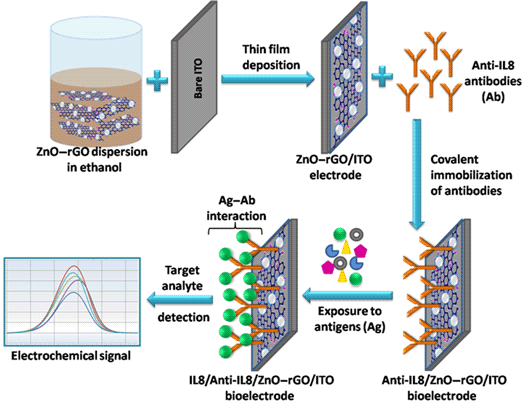Crossref Citations
This article has been cited by the following publications. This list is generated based on data provided by
Crossref.
Ehtesabi, H.
2020.
Carbon nanomaterials for salivary-based biosensors: a review.
Materials Today Chemistry,
Vol. 17,
Issue. ,
p.
100342.
Verma, Shilpi
Arya, Priyanshu
Singh, Anu
Kaswan, Jyoti
Shukla, Ajay
Kushwaha, Hemant R.
Gupta, Shalini
and
Singh, Surinder P.
2020.
ZnO-rGO nanocomposite based bioelectrode for sensitive and ultrafast detection of dopamine in human serum.
Biosensors and Bioelectronics,
Vol. 165,
Issue. ,
p.
112347.
Ridha, Noor J.
Alosfur, Firas K. Mohamad
Jumali, Mohammad Hafizuddin Haji
Tahir, Khawla J.
Madlol, Rajaa A.
and
Al-Dahan, N.
2020.
Ethanol sensor based on 1D and 2D ZnO nanostructures.
Vol. 2293,
Issue. ,
p.
050052.
Lin, Yen-Tzu
Darvishi, Sorour
Preet, Anant
Huang, Tzu-Yen
Lin, Sheng-Hsuan
Girault, Hubert H.
Wang, Ligang
and
Lin, Tzu-En
2020.
A Review: Electrochemical Biosensors for Oral Cancer.
Chemosensors,
Vol. 8,
Issue. 3,
p.
54.
Goldoni, Riccardo
Scolaro, Alessandra
Boccalari, Elisa
Dolci, Carolina
Scarano, Antonio
Inchingolo, Francesco
Ravazzani, Paolo
Muti, Paola
and
Tartaglia, Gianluca
2021.
Malignancies and Biosensors: A Focus on Oral Cancer Detection through Salivary Biomarkers.
Biosensors,
Vol. 11,
Issue. 10,
p.
396.
Moradpoor, Hedaiat
Safaei, Mohsen
Mozaffari, Hamid Reza
Sharifi, Roohollah
Imani, Mohammad Moslem
Golshah, Amin
and
Bashardoust, Negin
2021.
An overview of recent progress in dental applications of zinc oxide nanoparticles.
RSC Advances,
Vol. 11,
Issue. 34,
p.
21189.
Singhal, Jaya
Verma, Saurabh
Kumar, Sumit
and
Mehrotra, Divya
2021.
Recent Advances in Nano-Bio-Sensing Fabrication Technology for the Detection of Oral Cancer.
Molecular Biotechnology,
Vol. 63,
Issue. 5,
p.
339.
Chaudhary, Mohit
Verma, Shilpi
Kumar, Ashwini
Basavaraj, Y.B.
Tiwari, Pratibha
Singh, Sandeep
Chauhan, Sunil K.
Kumar, Pushpendra
and
Singh, Surinder P.
2021.
Graphene oxide based electrochemical immunosensor for rapid detection of groundnut bud necrosis orthotospovirus in agricultural crops.
Talanta,
Vol. 235,
Issue. ,
p.
122717.
Goldoni, Riccardo
Farronato, Marco
Connelly, Stephen Thaddeus
Tartaglia, Gianluca Martino
and
Yeo, Woon-Hong
2021.
Recent advances in graphene-based nanobiosensors for salivary biomarker detection.
Biosensors and Bioelectronics,
Vol. 171,
Issue. ,
p.
112723.
Kaur, Jasmeen
Srivastava, Rohit
and
Borse, Vivek
2021.
Recent advances in point-of-care diagnostics for oral cancer.
Biosensors and Bioelectronics,
Vol. 178,
Issue. ,
p.
112995.
Mhaske, Shubhangi
and
Yuwanati, Monal
2022.
Biosensor Based Advanced Cancer Diagnostics.
p.
113.
Ozkan-Ariksoysal, Dilsat
2022.
Current Perspectives in Graphene Oxide-Based Electrochemical Biosensors for Cancer Diagnostics.
Biosensors,
Vol. 12,
Issue. 8,
p.
607.
Agrahari, Shreanshi
Kumar Gautam, Ravindra
Kumar Singh, Ankit
and
Tiwari, Ida
2022.
Nanoscale materials-based hybrid frameworks modified electrochemical biosensors for early cancer diagnostics: An overview of current trends and challenges.
Microchemical Journal,
Vol. 172,
Issue. ,
p.
106980.
Li, Xiaojing
Liang, Xin
Wang, Yanhui
Wang, Dashan
Teng, Minhua
Xu, Hao
Zhao, Baodong
and
Han, Lei
2022.
Graphene-Based Nanomaterials for Dental Applications: Principles, Current Advances, and Future Outlook.
Frontiers in Bioengineering and Biotechnology,
Vol. 10,
Issue. ,
Sun, Hongyu
Li, Dujuan
Yue, Xiaojie
Hong, Rui
Yang, Weihuang
Liu, Chaoran
Xu, Hong
Lu, Jun
Dong, Linxi
Wang, Gaofeng
and
Li, Dongyang
2022.
A Review of Transition Metal Dichalcogenides-Based Biosensors.
Frontiers in Bioengineering and Biotechnology,
Vol. 10,
Issue. ,
Mattos, Gabriel J.
Marcheafave, Gustavo G.
Roldán, William H.
Mattos, Miguel J.
de Paula, Fabiana M.
Gryschek, Ronaldo C.B.
and
Sartori, Elen R.
2022.
Serological diagnosis of strongyloidiasis in immunocompetent and immunosuppressed patients based on an electrochemical immunoassay using a flexible device allied to PLS-DA and ROC statistical tools.
Sensors and Actuators B: Chemical,
Vol. 354,
Issue. ,
p.
131213.
Kaur, Jasmeen
Preethi, Mosam
Srivastava, Rohit
and
Borse, Vivek
2022.
Role of IL-6 and IL-8 biomarkers for optical and electrochemical based point-of-care detection of oral cancer.
Biosensors and Bioelectronics: X,
Vol. 11,
Issue. ,
p.
100212.
Pandey, Ritu
Arya, Neha
and
Kumar, Ashok
2022.
Biosensor Based Advanced Cancer Diagnostics.
p.
303.
Badillo-Ramírez, Isidro
Carreón, Yojana J. P.
Rodríguez-Almazán, Claudia
Medina-Durán, Claudia M.
Islas, Selene R.
and
Saniger, José M.
2022.
Graphene-Based Biosensors for Molecular Chronic Inflammatory Disease Biomarker Detection.
Biosensors,
Vol. 12,
Issue. 4,
p.
244.
Haghayegh, Fatemeh
Salahandish, Razieh
Hassani, Mohsen
and
Sanati-Nezhad, Amir
2022.
Highly Stable Buffer-Based Zinc Oxide/Reduced Graphene Oxide Nanosurface Chemistry for Rapid Immunosensing of SARS-CoV-2 Antigens.
ACS Applied Materials & Interfaces,
Vol. 14,
Issue. 8,
p.
10844.
